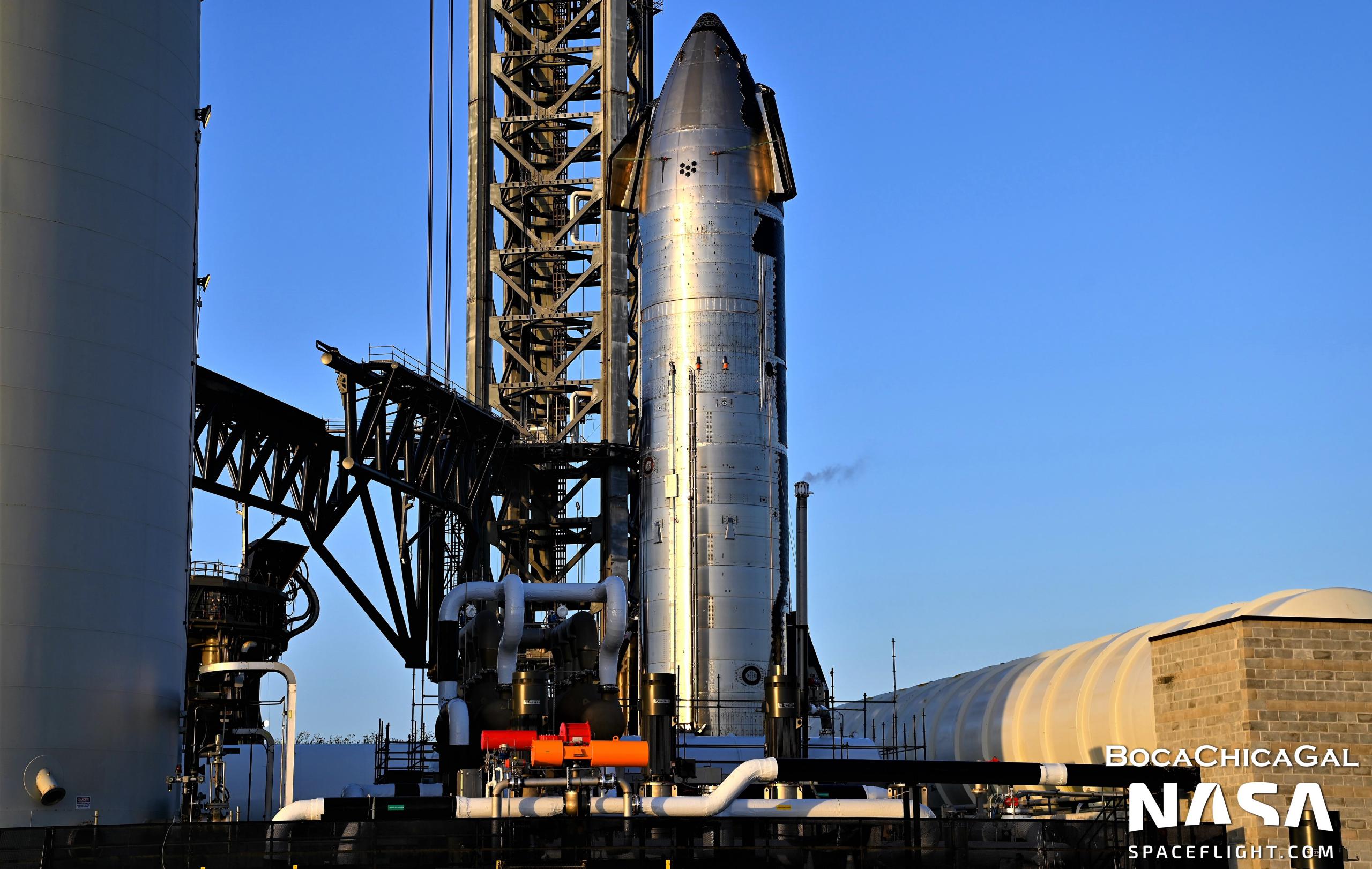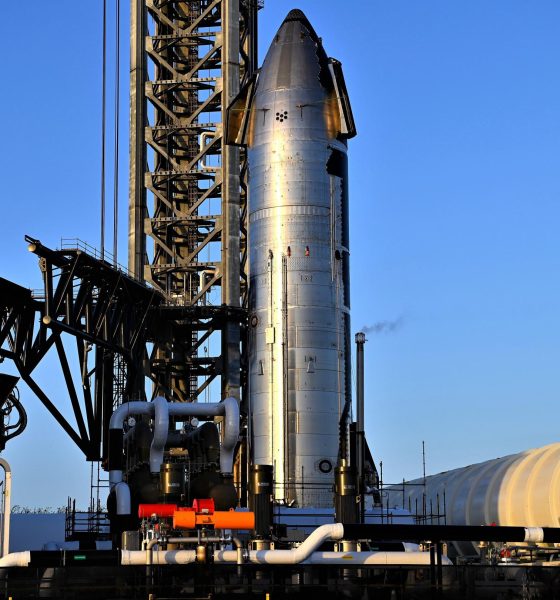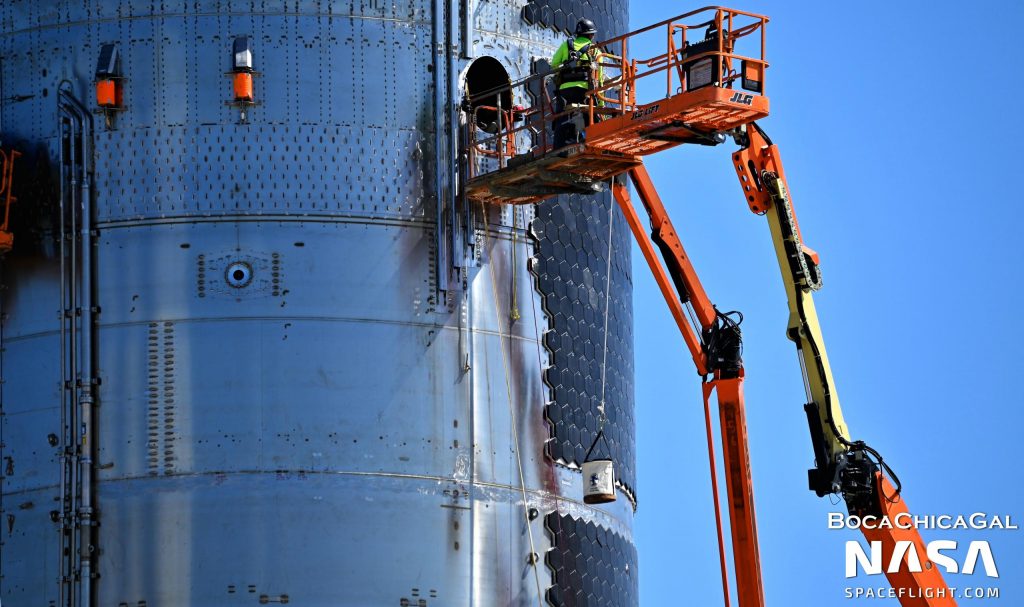

News
SpaceX repairing upgraded Starship prototype after first test
SpaceX workers have been spotted repairing the company’s newest Starship prototype in the days after the rocket’s first partial test.
Starship S24 was transported to SpaceX’s Starbase, Texas orbital launch site (OLS) on May 26th after about two and a half months of assembly, marking the first time SpaceX transported a new Starship prototype to a test stand since August 2021. Less than 24 hours later, after attaching Ship 24 to a new test bay located beside the actual ‘orbital launch mount,’ the Starship prototype came to life and began its first proof test.
Unfortunately, while it’s impossible to judge with certainty without official confirmation, Ship 24 either failed to complete that test or did not make it through unscathed.
Known as an ambient or pneumatic proof test, the main goal is to pressurize a Starship or Super Heavy prototype with nonflammable, ambient-temperature nitrogen gas to ensure that the rocket and all its plumbing are structurally sound and working as expected. A successful test would likely require a prototype to reach and sustain flight pressures – up to 8.5 bar (~125 psi) as of 2020 – without exhibiting any significant leaks or problems.
For a while, Ship 24’s first ambient proof test went about as expected, with lots of small vents from its main liquid oxygen (LOx) and methane (LCH4) tanks. No activity was visible at the ship’s nose, where vents and plumbing attach to a pair of small landing (header) propellant tanks. Ship 24 is the first Starship with an upgraded version of those tanks after SpaceX decided to remove the methane header tank from the main methane tank and relocate it directly under the oxygen header tank, which takes up the tip of Starship’s nose.
After an hour or two of testing, a muffled bursting noise different from previous vents was heard, followed by a quieter ‘whoosh’ more akin to a long vent. At the same time as the loud noise was heard, a good dozen or so of S24’s thousands of heat shield tiles were knocked off the section of the hull between the Starship’s main tanks and nose cone. SpaceX depressurized Ship 24 soon after and within a few hours, workers could be seen extracting a pipe from the ship that appeared to have been bent almost in half.

Three days later, workers were spotted guiding apparent replacement pipes into Ship 24. Altogether, it appears that some small section of Ship 24’s internal piping failed catastrophically after it was pressurized during the vehicle’s first pneumatic proof test, knocking tiles loose and possibly damaging other adjacent plumbing. Given the location of that piping inside Ship 24’s nose section, there’s a nonzero chance that the failure occurred when SpaceX attempted to pressurize the Starship’s new header tanks, which would have started by pressurizing the propellant and gas lines leading to them. That would explain the first muffled burst, the subsequent venting sound that slowly faded to nothing, and the loss of heat shield tiles.
It would also explain why SpaceX decided to leave Starship in place and conduct repairs at the pad. Super Heavy Booster 7, which suffered a dramatic plumbing failure during an early proof test, was moved back to one of Starbase’s covered assembly bays for repairs. Had Ship 24’s incident been severe, it would have likely left the pad as well. The fact that Ship 24 did not move indicates that the failure was fairly minor and contained, only impacting some easily-replaceable plumbing.

Additionally, SpaceX appears to have moved Raptor heat shield components and a missing cover for one of Ship 24’s four flaps to the pad since the incident. On top of the team that has been working all weekend to repair the Starship, other sets of workers have set about closing out Ship 24’s ‘raceway’, which protects hundreds of feet of smaller plumbing and cables and a flight termination system that runs from the top to the bottom of the ship’s tanks; and some have begun preparing to fill gaps in Ship 24’s heat shield. Most of that work can be classified as ‘finishing touches’ and none of it would be prioritized if Ship 24 was not in decent shape.
Still, even minor damage is a setback. Ship 24’s next opportunity for redemption is a 10am to 10pm CDT window on Wednesday, June 1st, with backup windows available on Thursday and Friday.

Elon Musk
Starlink passes 9 million active customers just weeks after hitting 8 million
The milestone highlights the accelerating growth of Starlink, which has now been adding over 20,000 new users per day.

SpaceX’s Starlink satellite internet service has continued its rapid global expansion, surpassing 9 million active customers just weeks after crossing the 8 million mark.
The milestone highlights the accelerating growth of Starlink, which has now been adding over 20,000 new users per day.
9 million customers
In a post on X, SpaceX stated that Starlink now serves over 9 million active users across 155 countries, territories, and markets. The company reached 8 million customers in early November, meaning it added roughly 1 million subscribers in under seven weeks, or about 21,275 new users on average per day.
“Starlink is connecting more than 9M active customers with high-speed internet across 155 countries, territories, and many other markets,” Starlink wrote in a post on its official X account. SpaceX President Gwynne Shotwell also celebrated the milestone on X. “A huge thank you to all of our customers and congrats to the Starlink team for such an incredible product,” she wrote.
That growth rate reflects both rising demand for broadband in underserved regions and Starlink’s expanding satellite constellation, which now includes more than 9,000 low-Earth-orbit satellites designed to deliver high-speed, low-latency internet worldwide.
Starlink’s momentum
Starlink’s momentum has been building up. SpaceX reported 4.6 million Starlink customers in December 2024, followed by 7 million by August 2025, and 8 million customers in November. Independent data also suggests Starlink usage is rising sharply, with Cloudflare reporting that global web traffic from Starlink users more than doubled in 2025, as noted in an Insider report.
Starlink’s momentum is increasingly tied to SpaceX’s broader financial outlook. Elon Musk has said the satellite network is “by far” the company’s largest revenue driver, and reports suggest SpaceX may be positioning itself for an initial public offering as soon as next year, with valuations estimated as high as $1.5 trillion. Musk has also suggested in the past that Starlink could have its own IPO in the future.
News
NVIDIA Director of Robotics: Tesla FSD v14 is the first AI to pass the “Physical Turing Test”
After testing FSD v14, Fan stated that his experience with FSD felt magical at first, but it soon started to feel like a routine.

NVIDIA Director of Robotics Jim Fan has praised Tesla’s Full Self-Driving (Supervised) v14 as the first AI to pass what he described as a “Physical Turing Test.”
After testing FSD v14, Fan stated that his experience with FSD felt magical at first, but it soon started to feel like a routine. And just like smartphones today, removing it now would “actively hurt.”
Jim Fan’s hands-on FSD v14 impressions
Fan, a leading researcher in embodied AI who is currently solving Physical AI at NVIDIA and spearheading the company’s Project GR00T initiative, noted that he actually was late to the Tesla game. He was, however, one of the first to try out FSD v14.
“I was very late to own a Tesla but among the earliest to try out FSD v14. It’s perhaps the first time I experience an AI that passes the Physical Turing Test: after a long day at work, you press a button, lay back, and couldn’t tell if a neural net or a human drove you home,” Fan wrote in a post on X.
Fan added: “Despite knowing exactly how robot learning works, I still find it magical watching the steering wheel turn by itself. First it feels surreal, next it becomes routine. Then, like the smartphone, taking it away actively hurts. This is how humanity gets rewired and glued to god-like technologies.”
The Physical Turing Test
The original Turing Test was conceived by Alan Turing in 1950, and it was aimed at determining if a machine could exhibit behavior that is equivalent to or indistinguishable from a human. By focusing on text-based conversations, the original Turing Test set a high bar for natural language processing and machine learning.
This test has been passed by today’s large language models. However, the capability to converse in a humanlike manner is a completely different challenge from performing real-world problem-solving or physical interactions. Thus, Fan introduced the Physical Turing Test, which challenges AI systems to demonstrate intelligence through physical actions.
Based on Fan’s comments, Tesla has demonstrated these intelligent physical actions with FSD v14. Elon Musk agreed with the NVIDIA executive, stating in a post on X that with FSD v14, “you can sense the sentience maturing.” Musk also praised Tesla AI, calling it the best “real-world AI” today.
News
Tesla AI team burns the Christmas midnight oil by releasing FSD v14.2.2.1
The update was released just a day after FSD v14.2.2 started rolling out to customers.

Tesla is burning the midnight oil this Christmas, with the Tesla AI team quietly rolling out Full Self-Driving (Supervised) v14.2.2.1 just a day after FSD v14.2.2 started rolling out to customers.
Tesla owner shares insights on FSD v14.2.2.1
Longtime Tesla owner and FSD tester @BLKMDL3 shared some insights following several drives with FSD v14.2.2.1 in rainy Los Angeles conditions with standing water and faded lane lines. He reported zero steering hesitation or stutter, confident lane changes, and maneuvers executed with precision that evoked the performance of Tesla’s driverless Robotaxis in Austin.
Parking performance impressed, with most spots nailed perfectly, including tight, sharp turns, in single attempts without shaky steering. One minor offset happened only due to another vehicle that was parked over the line, which FSD accommodated by a few extra inches. In rain that typically erases road markings, FSD visualized lanes and turn lines better than humans, positioning itself flawlessly when entering new streets as well.
“Took it up a dark, wet, and twisty canyon road up and down the hill tonight and it went very well as to be expected. Stayed centered in the lane, kept speed well and gives a confidence inspiring steering feel where it handles these curvy roads better than the majority of human drivers,” the Tesla owner wrote in a post on X.
Tesla’s FSD v14.2.2 update
Just a day before FSD v14.2.2.1’s release, Tesla rolled out FSD v14.2.2, which was focused on smoother real-world performance, better obstacle awareness, and precise end-of-trip routing. According to the update’s release notes, FSD v14.2.2 upgrades the vision encoder neural network with higher resolution features, enhancing detection of emergency vehicles, road obstacles, and human gestures.
New Arrival Options also allowed users to select preferred drop-off styles, such as Parking Lot, Street, Driveway, Parking Garage, or Curbside, with the navigation pin automatically adjusting to the ideal spot. Other refinements include pulling over for emergency vehicles, real-time vision-based detours for blocked roads, improved gate and debris handling, and Speed Profiles for customized driving styles.








